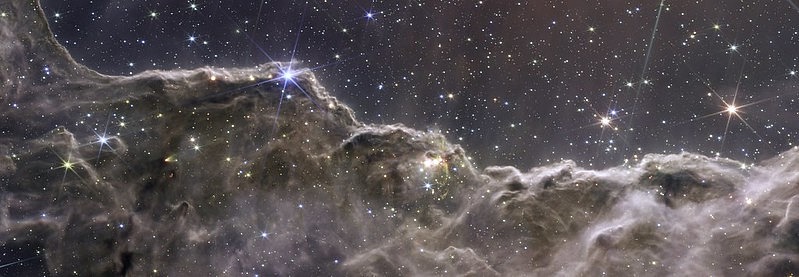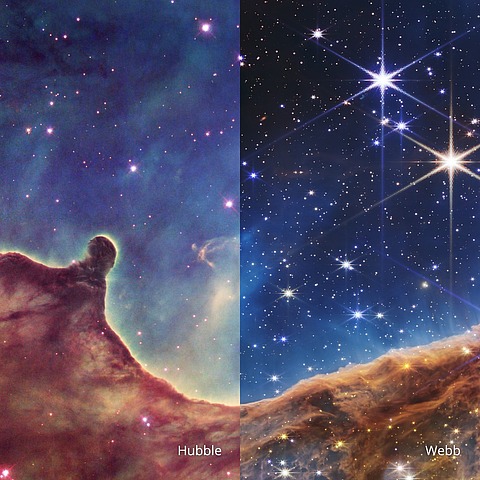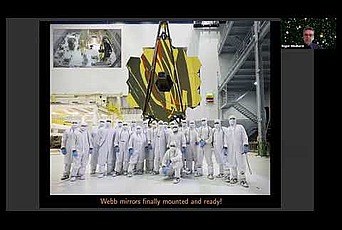The James Webb Space Telescope: What’s Next?

The launch of the James Webb Space Telescope (JWST) on December 25, 2021, and the recent release of its first images, has generated impassioned discussion across the IAS campus and beyond. The telescope has stunned the world with its images of never-before-seen astrophysical phenomena, captured in exquisite detail. Its ability to obtain such images stems from its capacity for observing in the infrared spectrum, which is invisible to the human eye.

Infrared telescopes can see things that visual-wavelength observatories like NASA’s Hubble Space Telescope, launched in 1990, cannot. For one, galactic dust clouds obscure many astrophysical objects from the view of telescopes like Hubble. However, most infrared light can pass straight through this dust, like X-rays passing through the body to create an image of a patient's bones, allowing us to see more of the universe. Moreover, like the change in pitch from a receding siren, light from distant receding galaxies is stretched––or “redshifted”––away from visible wavelengths and into the infrared. The James Webb Space Telescope is primed to collect images of precisely those faraway galaxies that would have escaped the view of Hubble.
Since infrared light is not visible to the naked eye, the data from JWST had to be processed and turned into a false color image before it could be put on the front page of the New York Times. The beautifully colored images that we see on TV and in press releases have been colorized by scientists on Earth. The colors are carefully chosen to give a “realistic” view of what the images would look like if we had infrared eyes, but also highlight particularly important features and make striking pictures for the media.
In its first five months of operation, JWST will collect data for a total of thirteen Early Release Science programs. During each program’s allotted observation time, scientists will decide what the telescope is “pointed at.” Exactly 17.4 hours of observation time has been allocated to a project co-led by Dominika Wylezalek (University of Heidelberg), Sylvain Veilleux (University of Maryland), David Rupke (Rhodes College), and former IAS Member and Visiting Professor Nadia Zakamska (Johns Hopkins University). The project is titled “Q-3D: Imaging Spectroscopy of Quasar Hosts with JWST Analyzed with a Powerful New PSF Decomposition and Spectral Analysis Package.”
We spoke to Zakamska, whose research group has been involved with JWST since 2017, to gain a deeper understanding of the telescope’s significance.
What new science will you be able to do with JWST?
I have a very broad range of scientific interests in astrophysics. Currently, all of my group's accepted programs for the first year of JWST observations are focused on supermassive black holes and their host galaxies. For example, we will be observing pairs of quasars which our group discovered a couple of years ago using data from the Gaia Mission and the Hubble Space Telescope in collaboration with Yue Shen (UIUC). Such pairs of quasars form when two massive galaxies collide and start merging, and the supermassive black holes in their centers both start swallowing gas and get activated as quasars–extremely bright sources of radiation emitted by the accreting gas. At least this is our current hypothesis for the nature of the close pairs of quasars we have discovered, and with JWST observations we will be able to detect the host galaxies in the throes of the merger and test whether these ideas are correct.
The rest of my group's programs focus on the so-called galactic winds. Quasars can produce so much radiation during the matter's final plunge into the supermassive black hole that the radiation pressure can push out much or all of the gas available in the quasar's host galaxy. This would have the effect of stopping star formation in the host galaxy for a long time, so quasar-driven galactic winds are thought to limit the maximal stellar mass of galaxies in the universe. About ten years ago, our group made some of the first observations of this process from the ground, and I spoke about some of the early results in a public talk at the Institute in 2013. Using JWST, we can now observe some of the most extreme galactic winds in the universe that were not observable from the ground. For the first time, we can study their impact on star formation, which has only been hypothesized so far.
In the future, I am planning to propose for JWST to observe a variety of other types of astronomical sources. Right now, I am excited about all kinds of exotic stars in our own galaxy, for example double white dwarfs that will merge due to emission of gravitational waves, anomalous white dwarfs that could be remnants of type Ia supernova donors, and powerful outflows from star-forming clouds.
How have you been involved in JWST before the image release?
In 2017, my research group participated in the very first general call for telescope proposals and were successful against greater than ten to one odds. This first proposal was co-led by my former postdoc Dominika Wylezalek—now a Group Leader at the University of Heidelberg—myself, Prof. Sylvain Veilleux and Prof. David Rupke. The advantage of this early start is that my group has long been familiar with the technical capabilities of the facility and has been developing tools for the scientific analysis of JWST data. On the flip side, we are now under enormous pressure to deliver the results and the software to the scientific community as quickly as possible, so this is what will be occupying me for the next few months.

What do you think the significance of JWST will be for the field of astrophysics as a whole?
I see two avenues for lasting impact. One of course is the sheer importance of scientific discoveries. By their nature, discoveries are somewhat unpredictable, but if I were to speculate, the most significant achievements of JWST will be in understanding of exoplanets and in studies of the very distant universe.
Following the ground-breaking discovery of the first exoplanet in 1995 by [Michael] Mayor and [Didier] Queloz (joint winners of the 2019 Physics Nobel Prize), thousands of planets outside of the solar system are now known. Many of them were discovered by NASA's Kepler Mission and more are now being found by NASA's TESS mission. JWST will shortly be providing the first glimpses into the atmospheres of these planets, allowing scientists to understand planet composition. On the distant universe side, the infrared capabilities of JWST will allow us to probe unprecedented cosmological redshifts, offering a tantalizing possibility of discovering the very first stars and galaxies in the universe. These objects are so distant that their light has taken most of the time since the Big Bang to reach us, and therefore we are seeing them as they appeared at the dawn of the universe.
In addition to tackling these fascinating topics, JWST will impact astrophysics and society as a whole in another important way. JWST was built as a general-purpose observatory, rather than to answer a particular scientific question. Furthermore, the scientific program of JWST, just like that of any other of NASA's Great Observatories, is determined by peer review on a competitive basis. And finally, the proposal process for JWST is open to anybody in the world. Thus, JWST will perform its observations in the true spirit of common human enterprise, where the whole community participates in defining the most exciting applications for this amazing new facility.
Do you think $10 billion multi-decade space telescope projects are the way forward in astrophysics research?
Interesting modern astrophysics is pursued on a very wide range of financial scales, from billion- and multi-billion-dollar facilities like Keck and JWST to multi-million-dollar satellites dedicated to a particular science goal, to university-owned smaller telescopes and radio dishes, to amateur astronomers with telescopes in their own back yards, to theorists with their paper and pens and fast computers. However, the frontiers of research and the scale of ambitions for American astrophysics are undoubtedly set by our flagship facilities. So what are some of the exciting, ambitious goals that may be worthy of such investment in the future?
Many years ago, when I was a member at the IAS and Professor Peter Goldreich was presiding over our daily journal club discussions, he said something that made an indelible impact on me, and I'll try to reproduce it as close to his original words as I can remember. “Life on other planets will be discovered in your lifetime,” he said, and took a pause while we all stared at him. Then he added, “not in mine, but in yours.” I think the statement struck me because Peter had never seemed a dreamer, so this came through as a realistic prediction.
One of the most profound, most fundamental quests of humanity is to understand our place in the universe and to determine whether there is life on other worlds. Looking beyond JWST, one of the most exciting frontiers for humanity would be to detect and characterize so-called habitable exoplanets. These planets are just the right mass to have a solid core and a thin atmosphere, like Earth, and are precisely at the right distance from their host star (and are therefore at the right temperature) to have liquid water on their surfaces.

Whether we are technologically and scientifically within reach of this goal was recently evaluated by the 2020 Astronomy and Astrophysics Decadal Survey. The report concluded that an $11 billion ultra-violet + optical + infrared telescope set to be launched in 2040 has “the potential to change the way that we as humans view our place in the universe” by being able to characterize habitable planets outside of the solar system. Furthermore, “This is a quest at the technical forefront, and of an ambitious scale that only NASA can undertake,” thanks to its prior leadership in space astrophysics.
Of course, I would like to see many other—perhaps more pressing—problems of humanity addressed on this timescale as well. But curiosity about our world and the creativity required to solve challenges in this quest are what makes us human and what has often driven technological progress. There should be no reason why a wealthy country such as the U.S. cannot both tackle practical issues such as public health and well-being and invest in fundamental astrophysics research, to continue and enhance U.S. leadership in science and higher education.

